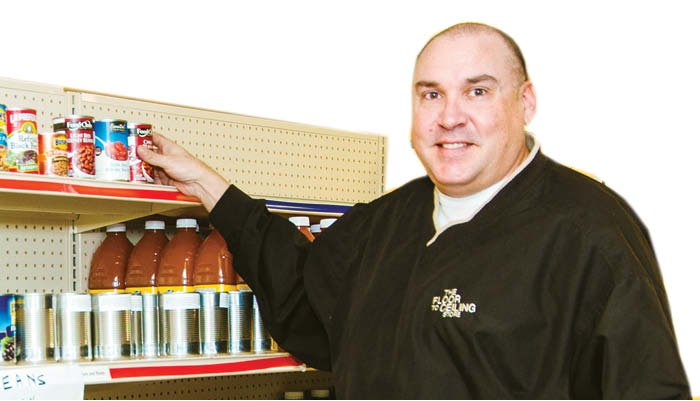Tony Eslinger spends the construction season working from dawn to dark at Cretex Concrete Products in Hawley, Minnesota. As the lead load man, he muscles its inventory of mammoth concrete culverts, driving the Caterpillar that loads a stream of semi trucks with the manufacturer’s mammoth pipe products.
But when frost shuts down the heavy construction season in November, he turns the seasonal lay-off into a chance to devote his days to a cause close to his heart – Moorhead’s Dorothy Day Food Pantry and its House of Hospitality, a homeless shelter housing about a dozen men.
After his annual layoff in November, Tony plunged into his fourth season with the local nonprofit. People are most familiar with the Dorothy Day organization’s shelter, which has operated at 714 Eight Street South since 1983. The food pantry – located at 1308 Main Avenue – is of more recent vintage, established in 1999 to offer families a way to keep their pantries stocked when times are lean.
“I get a real feeling of satisfaction from helping people out,” the Spicer-New London area native says. “What really got me into this is my parents. They’ve volunteered at home for a long, long time with Meals on Wheels. They’d always tell me how much they loved it. Now I really understand what they meant.”
His job at Cretex, though, is why he found himself calling Dorothy Day executive director Sonja Ellner to offer his services shortly after moving to Fargo-Moorhead. He was originally hired in the days when Cretex was located in Fargo just north of the railroad tracks on First Avenue North, an area often frequented by homeless people. Shuffling 18,000-pound concrete pipes around the lot, he’d uncover makeshift campsites and fire pits among the culverts and manholes, along with blankets and clothes left behind by homeless men who’d curled up inside for shelter.
“That’s what triggered me,”he says. “No one should have to live like that. These men are still people, and they have good hearts. There’s a lot of judgment in the community. That really bothers me.”
After a little research, he learned that the Dorothy Day House helps those who are down on their luck, offering them shelter and services to help them get back on their feet. He started out doing just that, sorting and warehousing donated furniture and household goods – then helping residents who are ready to set up their own apartments.
Tony was also introduced to Jim Manly, who runs the food pantry – a program that depends almost entirely on volunteers to unload donations, stock its food shelves and conduct the rest of the operations that are essential to what’s basically a small, private grocery store.
You see a crowd of the food pantry’s patrons lined up along Main Avenue during evening rush hour, Monday through Thursday. From young families to elderly men and women, they’re welcome to “shop” its well-stocked shelves once per month, choosing an allotted amount of pasta, canned vegetables and fruit, bread, produce, dairy and meat. Most of the food is donated, much of it through the Great Plains Food Bank in Fargo, as well as Land o’Lakes and area supermarkets. The rest comes from corporate gifts, community food drives and individual donations.
Tony, like other daytime volunteers, pitches in wherever he’s needed – unloading shipments from the Great Plains Food Bank, sorting donations, stocking the shelves, and also working with the donated household goods destined for the shelter and its residents. He handles logistics, too, making deliveries between the pantry and the shelter.
When the Dorothy Day Food Pantry’s doors open to clients – from 5:30 to 7:45 p.m. Monday and Wednesday and from 1 to 2:45 p.m. Tuesday and Thursday – a large force of community volunteers step in to help shoppers master the system and make their choices. Thousands work at the pantry in the course of a year, director Manly notes. They range from groups of corporate employees to college and high school organizations, church delegations, youth groups and fraternal lodges. Area high schools’ annual Fill the Dome project, he notes, is a big help.
Who are the little grocery store’s “shoppers”? Tony explains, “We’re here for anyone who needs a little help.” Patrons register with a personal ID on their first visit, then simply check in on future monthly trips. He estimates 40 to 50 families and individuals arrive on the average weekday. Fridays are a little different, with choices limited to perishable produce and bread, as well as personal care products; regular patrons are welcome every week between 9:45 and 11 a.m.
The food pantry averages 40 customers, adding up over the course of the year to more than 30,000 users – children, parents and singles who are able to keep food on their tables through the food pantry program. While they pay nothing for their groceries, their choices are weighed and tallied by the volunteers who help them load their bags and boxes. The free groceries add up dramatically: This year’s distribution tops out at about 600,000 pounds.
“Working here means a lot to me,” Tony reflects. “It’s hard to put that into words. I guess I can only say it feels great to be giving something back to our community. This is something I can do right here and right now to makepeople’s lives a little better.”



